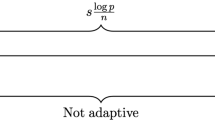Abstract
The usual way of conducting empirical comparisons among competing polynomial model selection criteria is by generating artificial data from created true models with specified link weights. The robustness of each model selection criterion is then judged by its ability to recover the true model from its sample data sets with varying sizes and degrees of noise.
If we have a set of multivariate real data and have empirically found a polynomial regression model that is so far seen as the right model represented by the data, we would like to be able to replicate the multivariate data artificially to enable us to run multiple experiments to achieve two objectives. First, to see if the model selection criteria can recover the model that is seen to be the right model. Second, to find out the minimum sample size required to recover the right model.
This paper proposes a methodology to replicate real multivariate data using its covariance matrix and a polynomial regression model seen as the right model represented by the data. The sample data sets generated are then used for model discovery experiments.
Access this chapter
Tax calculation will be finalised at checkout
Purchases are for personal use only
Preview
Unable to display preview. Download preview PDF.
Similar content being viewed by others
References
H. Bozdogan. Model selection and akaike’s information criterion (AIC): the general theory and its analytical extensions. Psychometrika, 52(3):345–370, 1987.
J. Rissanen. Modeling by shortest data description. Automatica, 14:465–471, 1978.
J. Rissanen. Stochastic complexity. Journal of the Royal Statistical Society B, 49(1):223–239, 1987.
G.W. Rumantir. Minimum Message Length criterion for second-order polynomial model discovery. In T. Terano, H. Liu, A.L.P. Chen, editor, Knowledge Discovery and Data Mining: Current Issues and New Applications, PAKDD 2000, LNAI 1805, pages 40–48. Springer-Verlag, Berlin Heidelberg, 2000.
G.W. Rumantir. Tropical cyclone intensity forecasting model: Balancing complexity and goodness of fit. In R. Mizoguchi and J. Slaney, editor, PRICAI 2000 Topics in Artificial Intelligence, LNAI 1886, pages 230–240. Springer-Verlag, Berlin Heidelberg, 2000.
V. Vapnik. The Nature of Statistical Learning Theory. Springer, New York, 1995.
C.S. Wallace and P.R. Freeman. Estimation and inference by compact coding. Journal of the Royal Statistical Society B, 49(1):240–252, 1987.
Author information
Authors and Affiliations
Editor information
Editors and Affiliations
Rights and permissions
Copyright information
© 2001 Springer-Verlag Berlin Heidelberg
About this paper
Cite this paper
Rumantir, G.W., Wallace, C.S. (2001). Sampling of Highly Correlated Data for Polynomial Regression and Model Discovery. In: Hoffmann, F., Hand, D.J., Adams, N., Fisher, D., Guimaraes, G. (eds) Advances in Intelligent Data Analysis. IDA 2001. Lecture Notes in Computer Science, vol 2189. Springer, Berlin, Heidelberg. https://doi.org/10.1007/3-540-44816-0_37
Download citation
DOI: https://doi.org/10.1007/3-540-44816-0_37
Published:
Publisher Name: Springer, Berlin, Heidelberg
Print ISBN: 978-3-540-42581-6
Online ISBN: 978-3-540-44816-7
eBook Packages: Springer Book Archive




